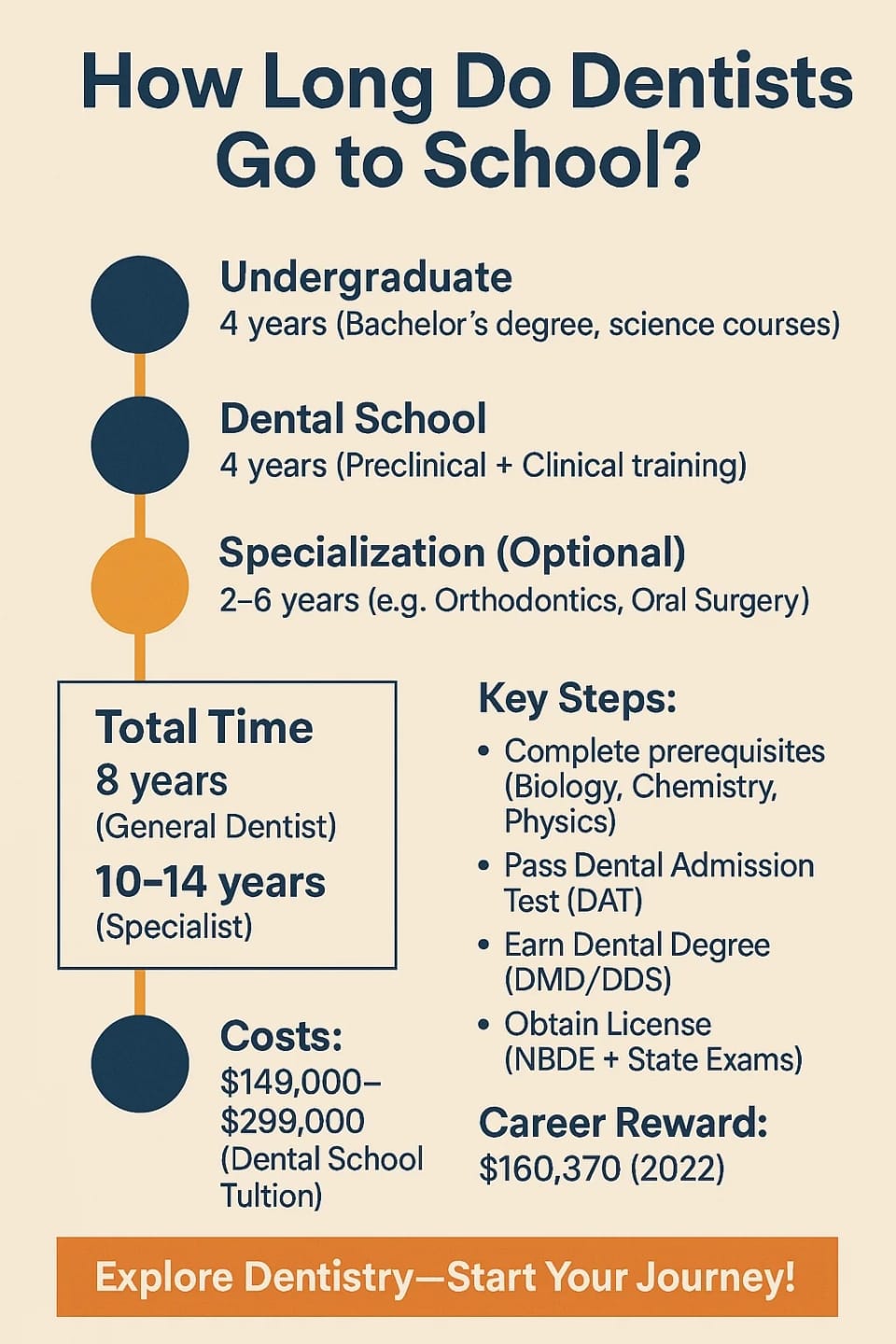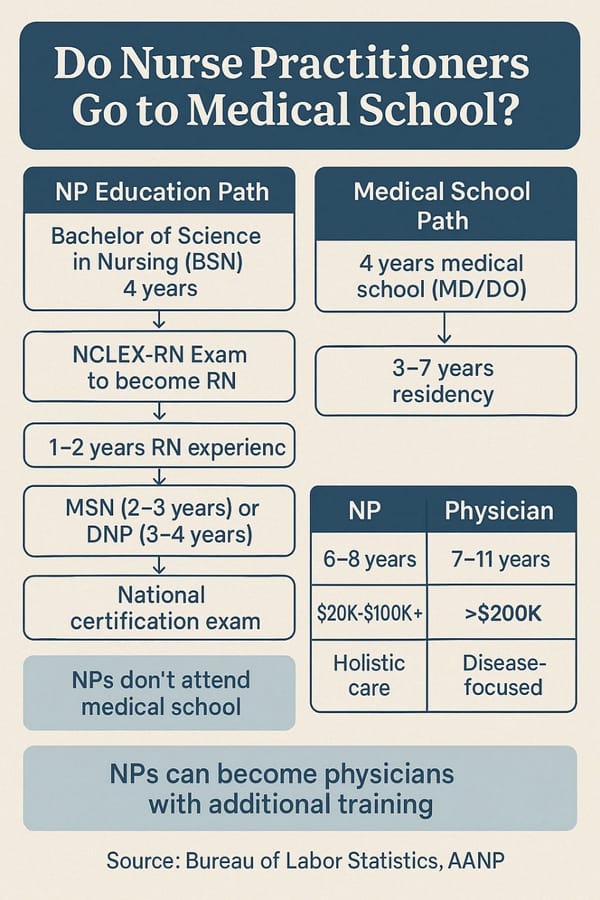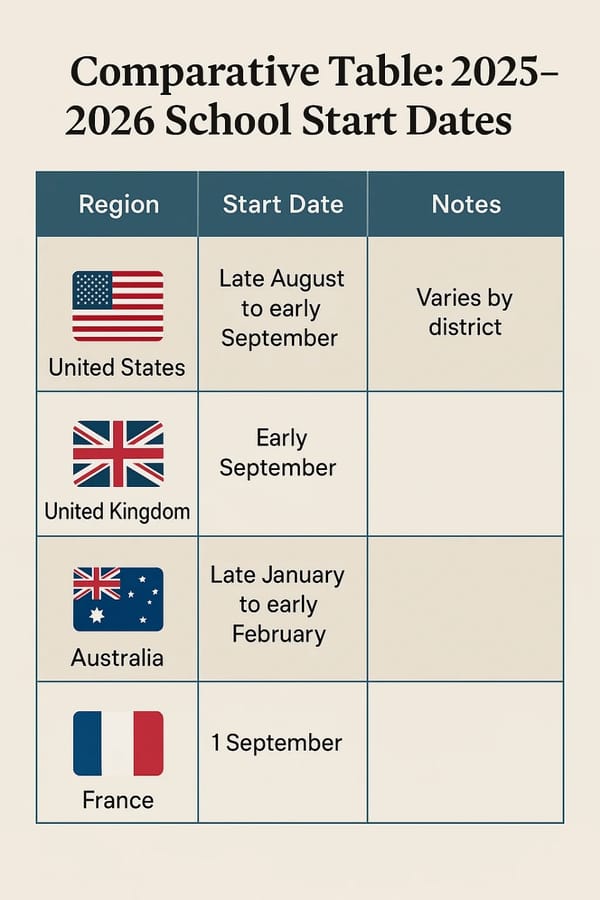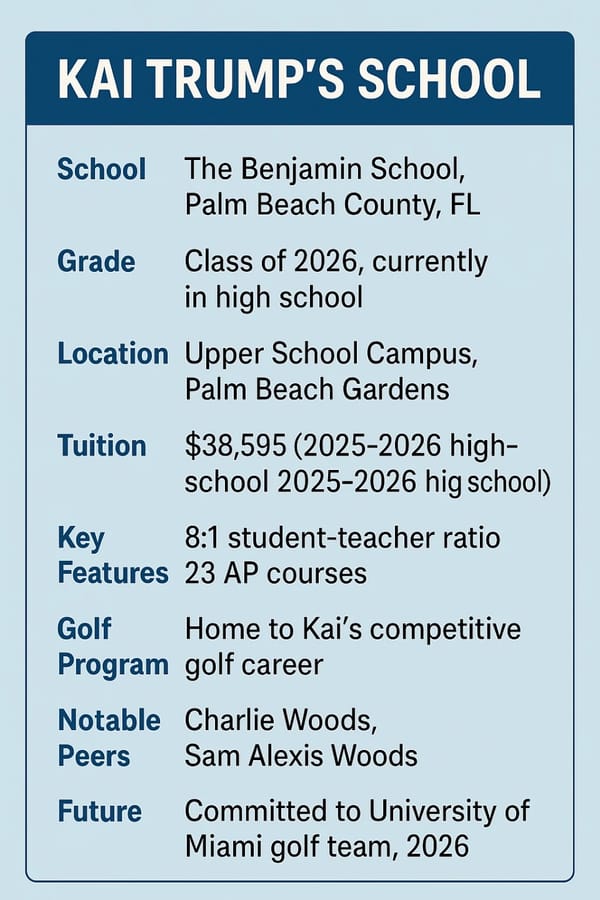Dental Education Timeline Calculator
Find out how long your path to becoming a dentist might take based on your educational choices and specialization interests.
How Long Do Dentists Go to School? A Comprehensive Guide
Wonder how long dental school takes? Learn about the entire educational timeline dentists follow and understand both the personal insights and requirements to enter this fulfilling career field.
The path to becoming a dentist is a desired career choice because it involves scientific knowledge alongside artistic ability to enhance people's lives through oral health. But one question often lingers: *how long do dentists go to school? * There isn’t a universal answer since the duration depends on your educational choices and the specialization you pursue. Students need around eight years post-high school to qualify as general dentists while choosing a specialty extends the training span to 10 to 14 years. Readers seeking guidance on the journey toward becoming a dentist will benefit from this comprehensive article that outlines educational paths, financial requirements, licensure processes, and real-world experience.
Why Does the Timeline Matter?
The duration required to become a dentist enables students to strategically organize their academic path and financial planning while setting their professional objectives. While dentistry requires a strong commitment it offers substantial benefits including professional fulfillment financial security and community involvement. Both high school students interested in premed careers and individuals looking to change careers can find comprehensive guidance in this resource which provides detailed steps supported by practical advice and expert information.
The Educational Path to Dentistry
Step 1: Undergraduate Education—The Foundation (4 Years)
Attaining a bachelor’s degree which takes about four years is the first step of the journey. Dental schools do not require a specific undergraduate major but expect students to have a solid background in science. The majority of dental programs require the following courses according to the American Dental Education Association (ADEA).
- Biology with lab: 2 semesters
- General Chemistry with lab: 2 semesters
- Organic Chemistry with lab: 2 semesters
- Physics with lab: 2 semesters
Some schools, like the [University of Washington School of Dentistry](https: The University of Washington School of Dentistry advises students to take courses in anatomy and microbiology and suggests including humanities classes for a comprehensive academic profile. English composition and social sciences frequently find their way to the required courses list, which helps students become both scientific experts and effective communicators.
Personal note: My friend studied psychology but had to take many biology and chemistry classes to fulfill dental school entrance prerequisites. She learned time management skills from balancing heavy science courses with her psychology major which later proved useful during her dental school education.
Students who want to accelerate their education can enroll in combined bachelor’s and dental degrees which consolidate undergraduate and dental training into 5-8 years. Competitive programs exist that enable dedicated students to shorten their dental education duration.
Step 2: Dental School—The Core Training (4 Years)
After earning your bachelor’s degree you face dental school which requires four years of study to turn you into a professional dental clinician. The ADEA’s dental school curriculum overview describes two main phases of dental education.
-
Years 1-2: Preclinical Studies
Students engage with demanding science topics including biochemistry, anatomy, physiology and microbiology alongside dental-specific courses like oral pathology. Students will learn procedures using models to master dental tools before they begin treating patients. The [University of Pittsburgh School of Dental Medicine](https: The University of Pittsburgh School of Dental Medicine provides first-year students with courses that cover molecular biology and histology while combining theoretical knowledge with practical skills. -
Years 3-4: Clinical Practice
Under supervision you’ll start working directly with actual patients during this stage. Your training will include rotations through different specialties such as pediatrics, orthodontics, and surgery in various clinical and community environments. Through direct interaction with patients of all ages the program strengthens your diagnostic and treatment abilities.
Why it matters: These years build confidence. As Dr. Naeema Munshi, a 2024 BDS graduate, shared, “From day one, we were plunged into an intensive curriculum... Lectures, clinical skills, and lab sessions filled the weekdays.” Her story on [CGDent](https: The CGDent article shows both the demanding aspects and the exciting process of learning sophisticated dental techniques.
Step 3: Specialization—Going Deeper (2-6 Years)
Pursue a career path as an orthodontist or oral surgeon. Residencies for dental specialties extend the educational journey by two to six years after dental school which results in a 10 to 14-year timeframe. The PlanetDDS blog breaks it down:
| Specialty | Residency Duration | What They Do |
|---|---|---|
| Orthodontists | 3 years | Align teeth and jaws |
| Pediatric dentists spend 2-3 years in training to concentrate on children's oral health care. | ||
| Periodontists | 3 years | Treat gum diseases |
| Endodontists undergo 2 to 3 years of additional training to specialize in root canal therapy and pulp disease treatment. | ||
| Oral and Maxillofacial Surgeons complete 4-6 years of education before performing complex surgical procedures. |
By specializing you gain greater expertise and better earning potential while having the opportunity to work with what excites you. Specialization requires substantial investment of time and energy and frequently leads to increased debt.
Licensure: The Final Gateway
Obtaining a dental school diploma does not complete your path to practice as obtaining a professional license remains necessary. The American Dental Association (ADA) explains that most states require:
- National Board Dental Examination (NBDE): The National Board Dental Examination (NBDE) is structured as two distinct sections that evaluate scientific understanding and clinical skills.
- State or Regional Clinical Exam: Hands-on abilities must be demonstrated through examinations such as NERB and CRDTS.
- State-Specific Requirements: States such as Texas require additional certifications or continuing education hours according to the Texas State Board.
Dental professionals need continuing education after licensure because requirements differ from state to state. Remaining current in a rapidly changing industry requires a minimal investment.
The Cost of Becoming a Dentist
Let’s talk numbers—dental school isn’t cheap. According to the ADEA the average tuition and fees for dental programs during the 2023-2024 academic year are:
- Public (in-state): ~$149,000
- Public (out-of-state): ~$224,000
- Private: ~$299,000
The combined total of living expenses and educational materials can make the financial burden seem overwhelming. Financial aid, loans, and scholarships provide essential support for many students. Personal tip: The National Health Service Corps provides loan repayment opportunities for dental professionals who work in underserved communities.
Real Voices: Student Experiences
The path isn’t just academic—it’s human. Christy Olsen, a dental hygiene student, shared her first patient experience: Christy Olsen remembers her first patient introduction was most challenging but learning to view patients as fellow humans helped her find calm.
According to Dr. Munshi daily dental school challenges are rewarding when patients express their gratitude through smiles.
Why Choose Dentistry?
Despite the long road, dentistry shines. The [Bureau of Labor Statistics](https: The Bureau of Labor Statistics reports that median dentist earnings reached $160,370 in 2022 while top dentists made more than $208,000. Dentists receive freedom through practice ownership and find fulfillment in transforming patients' smiles beyond financial benefits. The field is expected to grow by 4% until 2032 which will ensure job availability.
Fun fact: Dentists achieve high job satisfaction scores because their work combines patient care duties with problem-solving activities and creative tasks.
Common Questions Answered
-
The typical educational path for a dentist spans 8 years which includes 4 years of undergrad followed by 4 years in dental school. **
General dentistry requires 8 years of education split between a 4-year undergraduate degree and 4 years at dental school. Specialties add 2-6 years. -
**Can you become a dentist faster? **
BS/DDS programs or bypassing specialization offer shorter paths yet most students need 7-8 years to become a dentist. -
**Is dental school harder than undergrad? **
Dental school presents a more intense experience with denser coursework and clinical pressure but undergraduate studies develop the necessary skills to manage it.
Conclusion: Your Path to Dentistry
Dentists typically spend about eight years in school for general practice which extends to fourteen years if they specialize. * General practice requires 8 years of education while specialists need up to 14 years. The path to becoming a dentist requires an extensive educational journey that costs between $149,000 and $299,000 while blending science learning with practical experience and licensure requirements. Student stories demonstrate that pursuing dentistry requires growth while building resilience and leaving an impact. When you decide to enter dentistry you must begin planning by researching educational institutions and looking for scholarships or gaining experience through shadowing a dentist. Your future patients are waiting.
*What’s your next step? * Submit your thoughts below or explore more information through the provided links!






